![]() 5th String Banjo Capos
5th String Banjo Capos
![]()
Capos For Fretless Banjos
| In 1887 Wallace R Wood was the first to patent a capo for the fretless banjo. In front of the capo there was thin metal yoke that worked as a fret. The strings were threaded above the fret/yoke and under the capo. |
| Also the 5th string was capoed. It was threaded through a nut that could be placed in different sockets in the fretboard. | 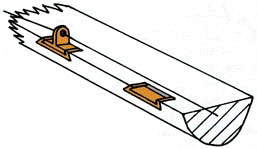 |
| Next year, 1888, Wood patented a sliding 5th string capo. The 5th string is threaded through a nut sliding on a rail. The sides of the rail are slanted and there is a dovetail joint between the sliding nut and the rail. The rail is fastened on top of the fretboard with screws. |
| I don't know if Wood's patents ever were realized. One drawback was that the strings were threaded through the capos, making them permanently attached to the banjo. But the next year this was cured: |
| Kilber & Gill US patent 1889 by Ray Gill & Frank A Kilber. This capo could be removed from the instrument and was primarily intended for fretless banjos or banjos with flush frets. It's a movable nut that is slipped under the strings. The 5th string has a nut at the end of the adjustable rod. On each end of the bar there is a hook intended for a rubber strap around the instrument neck. |
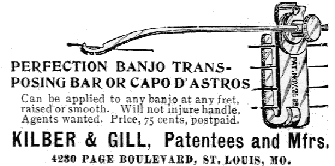 |
|
| According to the patent this capo was fastened
either with a screw clamp or a rubber strap, but in this ad the clamp is obviously
abandoned. The ad is from Cadenza magazine, May-June 1900, eleven years after the patent. This suggests that the capo was functioning. [Source: Mugwumps] |
| These are the only patents of capos for fretless banjos. Now, let's concentrate on the 5th string. |
![]()
Extra 5th String Nuts |
| A clever way of capoing the 5th string of a clawhammer banjo, is to install one or two extra 5th string nuts in the fretboard. For clawhammer playing this makes the 5th string easier to pick because it is elevated from the fretboard. Carving away the upper part of the fretboard, as many clawhammer players do, becomes unnecessary. This works for fretless banjos too. |
 |
 |
| To avoid buzzing, the 7th fret nut is placed
aside and both the extra nuts are lower than the 5th fret nut. The 9th fret nut is lined
up with the 5th fret nut, but note that 5th fret nut elevates the string to the same level
as the other strings, allowing it to vibrate free above the 9th fret nut. To prevent the string from popping out of the groove in the nut when played hard, the string is slipped under the head of a small tack located at the fret behind the extra nut. |
![]()
| Small Hooks |
| The most preferred way to capo the 5th string is to slip
the string under small hooks permanently installed in the fretboard. Installed correctly
you won't notice them when you fret the string because they are lower than the frets. They
add no extra width to the fretboard which is an advantage - specially when you fret the
5th string with the thumb. A slight disadvantage is that they require some retuning. . |
 |
| . Nowadays HO-scale model railroad spikes are used, but in the old days you had to be inventive. Banjoplayer Curtis McPeake: |
 |
"I used very small crochet hooks. I would get one with a very small shank and snip the hook off about 1/4" down he shaft and drill the board and install it. It worked well. Some have used hairpins bent with L shape and set into the board. I have seen small headed tacks put into the board and clip the fifth string under the head of the tack. When the HO-spikes came along, it helped us older boys out a lot." |
| . |
| Janet Davis Acoustic Music has hooks for this purpose. |
![]()
Sliding Capos
| Pittman | 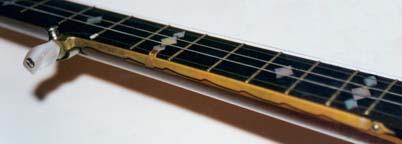 |
Walt Pittman invented the sliding capo with a waved rail in the late 1950's. This capo is not patented as each one has to be made by hand to fit each banjo. One end is anchored around the shaft of the 5th string key under the button, the other end is screwed to the side of the fretboard. A small fretting hook is sliding along the rail, fretting the string when located on a thick part of the rail and passing the frets on the top of the waves. When not in use the hook rests behind the 5th string nut. If required the rail can be made slightly curved to compensate flexing. |
|
| Ode |  |
 |
In the sixties Ode marketed a variation of the Pittman capo that was attached with a screw in each end. |
Vega-Pittman

| Walt Pittman designed another 5th string banjo capo. This one is more commercial, but I have not found any patent. It has a straight rail screwed to the side of the fretboard and a small spring sliding on the rail to fret the string. It was first marketed by Vega and is still marketed under different names. |
Shubb

| US patent 1974 by Richard Shubb. This capo also* uses a dovetail joint between the rail and the sliding fretting mechanism. The rail is screwed to the side of the fretboard and the fretting lever is operated by a screw making the string pressure adjustable. Manufactured and marketed by Shubb. |
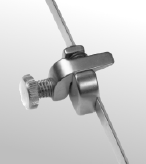 |
* See Wood's sliding capo from 1888 at the beginning of this page. |
Pothoven

| This one has a round slide bar which is
flattened on the outside. In action the round tip of the thumbscrew
presses against the lower part of the flat side of the bar. Thus the
down force on the 5th string is adjustable. Clever! When not in use the capo is fastened in the offset position. Made by Wouter Pothoven, Netherlands. |
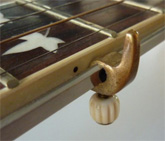 |
![]()
Removable 5th String Capos
| Clock Spring Capo |
| In his book How To Play The 5-string Banjo, Pete Seeger suggests a 5th string capo invented by songwriter Ernie Marrs. It was made out of a clock spring. The lower end hooked into a narrow groove dug in the back of the neck, exactly parallel to the edge of the fingerboard. Did anyone try it? |
| Paper Clip Capo |
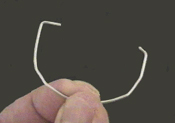 |
Most likely inspired by the capo above, this 5th string capo was invented by Marc W Mauss, New York, in in the early 1960's. It is made out of a paper clip and hooks around the edges of the fretboard. |
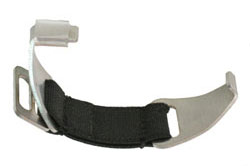 |
Suspender Capo Here is refinement of the paper clip with an elastic strap and a small handle. US design 2006 by Earl J Fowler. |
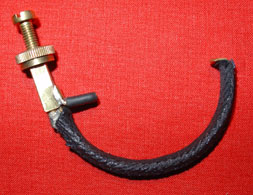 |
Svalander Capo This one is home made by Per Svalander, Sweden. Soldered brass hardware with plastic and textile tubing. |
Small Cramp |
| Small holes, about 1/4" deep, are drilled into the side of the fingerboard like you would for a position dot. The holes are drilled just behind the frets. A small round piece of steel is bent into a U-shape. Insert it into the hole and then hook the 5th string under it. |
| I saw this capo described in a banjo instruction book, maybe in the early
1970's, but I never saw it again - until thirty years later: . |
| This long neck, aluminum Merlin banjo made in the 1960’s utilises
this idea. It is a little piece of springy wire. One end is flattened for slipping
over the fifth string. For storage, one end goes into one of the little holes and the
other end goes into one of the larger holes, parallel with the fingerboard. [Owner: Tom Gocze, Maine USA.] |
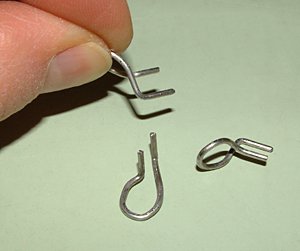 |
These have a loop handles and were made by Hans Holzherr, Switzerland. "Back then I made several because I knew that I would lose them sooner or later." |
Holzherr |
| On half of the perimeter the knurled ring had a varying thickness,
changing the angle of the L-shaped lever as the ring was turned. Half a turn was required
to bring down the lever on the string. The angled milling of one half of the ring made two
'steps' in the ring which acted as stops for the two extreme positions. The capo was inserted into two small holes at the side of the fretboard. The second capo only required one hole per fret. |
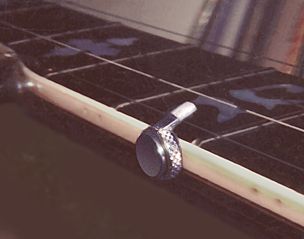 |
The next three capos are slipped under and elevates the 5th string, making it
impossible to fret
the string close to the capo. For clawhammer playing the 5th string becomes easier to pick
because it is lifted to the same level as the other strings. They both work on fretless
banjos as well.
| A screw under the string | |
| A very simple way to capo the 5th string is to slip a short screw under the string just behind the fret. The head of the screw stops against the edge of the fretboard. The screw raises the string above the fret and works as a nut with the string resting comfortable in one of the threads. Remove the threads on one side to protect the fretboard. Make the end of the screw slanted to facilitate slipping the screw under the string and to make room for the fingers to fret the 4th string. If it rattles when played hard, put the string in a thread closer to the head of the screw. | 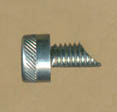 |
| Reagan US patent 1995 by Gomer M Reagan. |
 |
This capo is attached to the 5th string. The string is slipped into the slot and fastened with the thumbscrew above or just behind the desired fret. A small felt pad at the bottom protects the fretboard. (The picture is about twice the real size.) |
| Janet Davis Acoustic Music have it. |
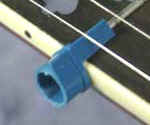 |
Pen Cap Capo The ingenuity of man is fascinating. This one is made out off a pen cap, riding on the fret. Made by Bob Skluzacek, California. |
Eagle Claw |
|
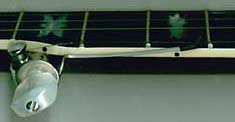 |
|
| A set of four removable capos (for fret 7, 9, 10 and 12) that attaches to the fifth string tuning peg. Made of spring tempered stainless steel. Custom lengths can be ordered. The capo is anchored around the string post, wrapped under the peg and placed upon the string. The washers are mounted on the shaft of the peg to support the capo sideways. No installment damages to the banjo neck. The capos are stored by the two magnets, e.g. at the brackets. | |
Made and marketed by Tone Techniques LLC. |
![]()
Capo Trick Normally the 1st and 5th strings sound unison when
you fret them at the same fret. Here is a trick with the 5th string capo that will open up
for some new banjo sounds, particularly if you play in the melodic style. |
![]()